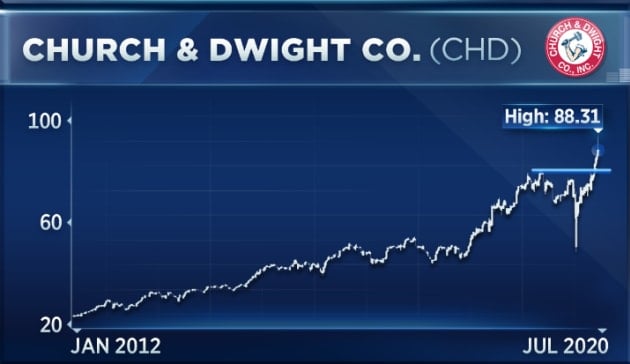Consumer staples stocks are bouncing back.
The sector has climbed over 1% since Monday, on pace to be the S&P 500′s best-performing group week to date as of Tuesday’s close.
Consumer staples stocks on the whole, tracked by the Consumer Staples Select Sector SPDR Fund (XLP), are practically flat for the year, down less than half of 1%.
That’s because the group is fracturing from the market’s uncertainty about what comes next in the Covid-19 crisis, traders Steve Chiavarone and Todd Gordon told CNBC’s “Trading Nation” on Tuesday.
“You can look at food names in two groups. There’s the stay-at-home-exposed names, and then there’s the restaurant-exposed names,” said Chiavarone, a portfolio manager, equity strategist and vice president at Federated Hermes.
Seaport Global Securities initiated coverage of seven consumer staples stocks on Tuesday that it said could come out of the pandemic “stronger entities,” placing buy ratings on Kellogg, Mondelez, Archer-Daniels-Midland and Simply Good Foods and neutral ratings on Tyson Foods, B&G Foods and Andersons.
Also Tuesday, shares of Monster Energy, Kimberly-Clark and Church & Dwight hit record highs. Conagra Brands and Kellogg’s stocks also climbed, reaching fresh 52-week highs.
“It’s really all about the pace of reopening,” Chiavarone said, adding that the recent case count “flare-up” in some parts of the country is “obviously bad for the restaurant names [and] very good for the stay-at-home names.”
As such, stay-at-home stocks are probably safer bets for investors now, he said.
“However, when and if we do get progress on a vaccine and we start to see a reacceleration of reopening again, you probably have a lot of value in the restaurant names,” he said. “So from our perspective, we’re leaning towards the stay-at-home portion, but we’ve got a real watchful eye on the restaurant-exposed names here.”
Gordon, managing director at Ascent Wealth Partners, said his firm was largely underweight consumer staples, calling the group “generally mature,” “a slow grower” and “very fully valued.”
“Because we’re seeing a move down in interest rates, we’re starting to see staples have a pretty good degree of correlation towards rates,” he said. “In terms of valuations, according to S&P, staples are trading about 20 times next year’s earnings, estimated to grow at about 5%. If you compare that to technology, which is at 24 times next year’s earnings, they’re expected to grow 14%. So, staples are fairly fully valued.”
If investors were to peruse the pantry plays, Gordon suggested a company focused largely on health, sanitation and personal care: Church & Dwight, whose brands include Arm & Hammer, OxiClean, Orajel and Arrid.
“We like its long-term prospects. It’s one of the better kind of top-line growers,” he said. “They have a lot of exposure to cleaning supplies. They’ve been gaining market share.”
On top of that, “the chart looks good,” Gordon said.
“We broke through 80 as resistance, and what was resistance becomes support,” he said. “So, we hold CHD, but generally underweight staples.”
Investors should also pay attention to consumer staples companies that are at risk of cutting their dividends, particularly with the U.S. 10-year Treasury yielding less than staples stocks, on average, both traders said.
“Companies that can maintain, defend and grow their dividends are going to be scarcer, and we think that there’s a premium paid for that,” Chiavarone said. “We think it’s hugely important because it really is not only a sign of health and defensiveness, but income that a lot of investors are looking for and having a hard time finding elsewhere.”
Gordon said the work-at-home, stay-at-home environment has brought about a “new norm” for dividend plays.
“We’re starting to see more technology stocks with rock-solid balance sheets, fortress balance sheets, yet dividends are not going anywhere, act more [like] staples than staples are acting,” he said, citing Apple as one example.
“There’s just unbelievable amounts of examples of tech that’s paying a solid dividend and that’s acting as sort of a defensive sector in here,” Gordon said.

